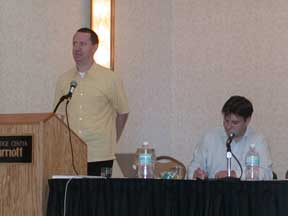The concept of the user and user-centred design is central to the history of SIGCHI. But today, does a diminished view of the user, and corporate cowardice, leave people short-changed with respect to the design of new products?
This panel proposal was accepted for the ACM SIGCHI Designing Interactive Systems 2004 (DIS2004) conference. The panel proposals were reviewed by Tracee Vetting Wolf, of the IBM T.J. Watson Research Centre, and Michael Smyth, of the Napier University (Edinburgh) School of Computing. The panel will took place 11:00-12:30 on Wednesday 4 August. Other accepted panels were ‘Design for Hackability’, ‘Producing the Future – Writing, Design and Research on NOT-Linear Interaction’, and ‘Science Friction’. Full information on the panels can be found on the DIS2004 site.

Panel documentation
Robert Reimann’s presentation [PDF, 448 KB]
An aritlce reporting the position paper, panelist’s introduction, and ensuing discussion can be found in ACM interactions, Volume 12, Issue 2, March + April 2005, pp75-79 [paid subscription required].
I am currently writing an article developing on the panel for the AIGA Journal).
Peter Merholz of Adaptive Path wrote a post inspired by the panel, and a related essay ‘Organization in the Way: How Decentralization Hobbles the User Experience’ (September 5, 2004).
Panel participants
Robert Reiman, manager, User Interface Design, BOSE Corporation, Framingham, Mass., formerly at Cooper, Palo Alto, CA: Reimann is one of the most articulate proponents of user-centred design in general, and the use of personas in particular. He is co-author of a key text in this field, About Face 2.0 Alan Cooper, Robert M Reimann (John Wiley & Sons, 2003).
Martyn Perks, user experience consultant with Corporate Edge, London, UK: Writes in the UK mediaabout design, technology and politics. Articles include ‘Ethnography exposed’ Martyn Perks, spiked-IT, 30 December 2003.
Aaron Oppenheimer, Design Continuum in Boston, Mass., USA, is Principal Product Behaviorist at Design Continuum. The company’s clients have included Hewlett-Packard, General Motors, Sunbeam, Harvard Business School, and Samsung. Oppenheimer holds a degree in computer engineering from Carnegie Mellon University. Personal page on company site.
Proposal
The concept of the user and user-centred design is central to the history of SIGCHI and the culture the Designing Interactive Systems conferences.
The idea of the user and designing around user requirements and contexts of use were a radical development in relation to a culture of computing that had evolved around scarce computing power to focus on efficient use of these resources and the needs of computing technicians.
In recent years the concept of usability, a key element of user-centred design, has become a core – almost defining – aspect of Web and, to a lesser extent, software design. To criticise a Web site for being unusable brooks no defence.
Today the concept of user-centred design is entirely accepted by practitioners, and largely accepted by clients, though it is still often honoured in its breach. At CHI2000 the concept of user-centred design was abandoned in favour of human-centred design by John Thackara, who in his opening keynote talked about “the people, formerly known as “users’” (drawing on a speech by James Woudhuysen at Design Renaissance, Glasgow, 1994).
More than ever, business leaders are focused on users – or, in their context, consumers – and driven by focus groups, consumer surveys, market trends analysis, ‘cool spotting’, and even ethnographic research.
The recognition that people should be the focus of the design and development of computer-based systems is undoubtedly positive. However, this development may mask more questionable developments.
The point at which user-centred design has come to the fore is also the period in which innovation in design is at a low ebb. Yet the challenges of designing interfaces to computer-based systems are greater than ever. The personal computer is no longer document-centric, but used for a plethora of activities and tasks, in a variety of contexts. The WIMP graphical user interface can no longer support people using computers. Meanwhile digital interfaces are appearing on more and more devices, in the home, in the workplace, and in public spaces. Increasing numbers of devices are connecting to networks, and in developed countries Internet access is becoming pervasive. The need for pioneering design solutions is greater then ever.
Today, the advocacy of the user is often presented in terms of victimhood rather than their innate abilities and adaptability. The concept of human agency – the idea that humans are proactive and problem-solving determiners of their own situations – tends to be replaced with a view of them in the least positive light.
Is user research helping designers’ to really understand the people for who they are designing, or blinkering designers view of possible solutions? Is user-centred design ensuring that products fit the needs and contexts of users, or acting as a bulwark to qualitative developments in interface design? Is usability ensuring that design concepts are honed to people’s abilities, or suffocating the design process with iterative and incremental approaches? Does human-centred design deliver the best tools for people, or shape tools with low expectations of users? Do tools developed in this manner empower people, or do they encourage a therapeutic relationship with users?
Structure
The panel will be introduced by Nico Macdonald, who will then set the scene and outline what may be a relatively new angle on the discussion of human centred-design. Panelists will be asked to present their view on the themes for 5-7 minutes, without visual support. We will alternate between panellists who tend to support established views, and those who are critical of them. This will take around 35 minutes, which will allow for 35 minutes for questions and points from the audience, with perhaps four rounds of answers from the panellists. The last 10 minutes will be used for summing up and thanks.

